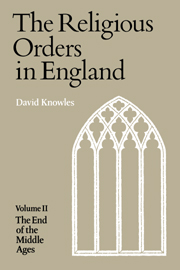Book contents
- Frontmatter
- Contents
- Preface
- List of Abbreviations
- Part One The Historical Framework
- Chap. I The opening of the period
- Chap. II Monks and canons at the university, 130c–1450
- Chap. III Patrons and architects: Ely and Gloucester
- Chap. IV Portraits of monks
- Chap. V Monks and friars in controversy
- Chap. VI Trends in speculation: Ockhamism, justification and grace
- Chap. VII Criticism of the religious in the fourteenth century
- Chap. VIII The spiritual life of the fourteenth century
- Chap. IX Developments within the orders: I
- Chap. X Developments within the orders: II
- Chap. XI The fortunes of the Cluniac houses and the alien priories
- Chap. XII The loosening of discipline
- Chap. XIII King Henry V
- Chap. XIV More portraits of monks
- Chap. XV The second century of visitation, 1350–1450
- Chap. XVI The spiritual life of the fifteenth century
- Part Two The Institutional Background
- Appendix I Chaucer's monk
- Appendix II Henry V and the Westminster recluse
- Appendix III Regulars as bishops
- Bibliography
- Index
Chap. XIV - More portraits of monks
Published online by Cambridge University Press: 28 January 2010
- Frontmatter
- Contents
- Preface
- List of Abbreviations
- Part One The Historical Framework
- Chap. I The opening of the period
- Chap. II Monks and canons at the university, 130c–1450
- Chap. III Patrons and architects: Ely and Gloucester
- Chap. IV Portraits of monks
- Chap. V Monks and friars in controversy
- Chap. VI Trends in speculation: Ockhamism, justification and grace
- Chap. VII Criticism of the religious in the fourteenth century
- Chap. VIII The spiritual life of the fourteenth century
- Chap. IX Developments within the orders: I
- Chap. X Developments within the orders: II
- Chap. XI The fortunes of the Cluniac houses and the alien priories
- Chap. XII The loosening of discipline
- Chap. XIII King Henry V
- Chap. XIV More portraits of monks
- Chap. XV The second century of visitation, 1350–1450
- Chap. XVI The spiritual life of the fifteenth century
- Part Two The Institutional Background
- Appendix I Chaucer's monk
- Appendix II Henry V and the Westminster recluse
- Appendix III Regulars as bishops
- Bibliography
- Index
Summary
WILLIAM CLOWN
Rarely, after the years of the first fervour in the twelfth century, are we given a chronicler's portrait of the head of a house of Austin canons. For this reason, as well as for its intrinsic interest, we may for a moment glance at the career of Abbot Clown of Leicester. The abbey of Leicester had in earlier centuries been a well-to-do but undistinguished house. It had prospered, especially from its sale of wool, and the abbot had for that reason been summoned to Edwardian parliaments. No doubt the fortunes of the abbey had also been influenced by connexions with the court that had begun when, from 1245 onwards, the earldom of Leicester had been held by the royal earls of Lancaster. Its period of greatest prosperity opened with the election of William Clown, a century later, in 1345. The new abbot, who probably took his name from a village in Derbyshire, was to hold office for more than thirty years, and the steady growth in the prosperity, and also, it would seem, in the good governance of the monastery, which coincided so nearly with the abbacy of Thomas de la Mare, is one more indication that the Black Death should not hastily be invoked as a catastrophic agent of universal scope. The pestilence ravaged the town of Leicester, and served as an excuse, or an occasion, for the appropriation of some churches, but it did not seriously affect the fortunes of the house.
- Type
- Chapter
- Information
- Religious Orders Vol 2 , pp. 185 - 203Publisher: Cambridge University PressPrint publication year: 1979



